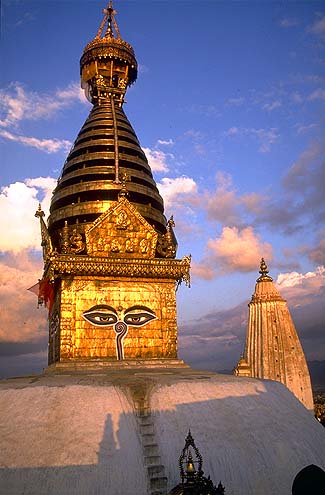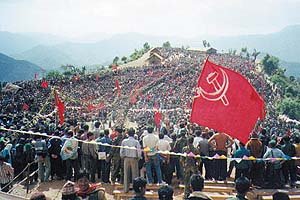
[The eyes of Lord Buddah peer out from the Swayambunath Monkey-temple, high above Kathmandu, Nepal]
Nepal called to me in dreams from the core of my soul. I don't know when I first thought of Nepal as a destination I had to see. Was it mentioned in some half-remembered travel program? A book on Hindu sculpture I chanced upon? A photo journalist essay featuring blurred photos of muddy Kathmandu streets? Somehow Nepal crept into my dreams and planted itself. I knew that "I would go to Nepal one day". By fate, a humanitarian urge and a prototype art project I had created for Tibetan refugee children were the seeds that brought me to Nepal finally in 2001. My trip was amazing. Since that time I have watched in shock and dread as the last Hindu kingdom on earth has become embroiled in a social and political tragedy that is testing every spirit in the tiny country and will direct the future of the entire Indian sub-continent.
It was a life-changing trip for me. I was able to experience my dream come true, while being able to meet people beyond my dreams. One of them was an artist named Kiran Manandhar.
Kiran is the most famous visual artist in Nepal. He is a charismatic, articulate and passionate man. As president of the Artists Society of Nepal (ASON) he holds great power in the eyes of his fellow Nepali artists. I met Kiran through some other very talented painters while visiting Kathmandu, the almost medieval city of mysterious temples, crazed tourist ghettos and chaos. "You must meet Kiran", everyone told me, and a meeting was arranged. The day finally came to visit him in his lavish studio, housed in a neo-classical palace which looked airlifted out of Vienna or London, and placed in the middle of a crumbling Nepalese neighborhood.
truly, the artists who keep their studios in this prestigious building are held in the greatest esteem. As artists of the Royal Academy, they are officially the brightest lights of Nepali culture. Kiran Manandhar's studio was the largest, housed at the top floor, with the roof of the building serving as his extended patio. The views of Kathmandu from the roof were stunning , but clearly exhibited the poverty of the city far below. The white neo-classical palace, with it's tall columns and decorative features was very much a citadel.
Kiran extended kindness and a warm welcome to us. He brought in hot milk-tea and snacks as my wife and I surveyed his paintings. Abstract expressionism was becoming the new movement in Nepal, and Kiran was a master of it. Vibrant colors, thick impasto strokes, written text and occasional found objects were his forte, with much of his work feeling as playful as Picasso's. Bright colors and confident experimentation helped each canvas to radiate with strength.
When asked about my own paintings, I introduced Kiran to my series of portraits of missing children. The social aspect of my work interested him and we talked about the future of Nepali art. How might it evolve? Abstract expressionism conveys emotion and activity to the audience, but can just as easily alienate and put off viewers. Could the art of the great Nepali contemporary painters address the heavier social issues facing the world?
Of course, some of the Nepali artists we met on our journey scratched their head when asked this same question. "Social issues?" They replied that they would rather paint the mountains , or the lush green landscape. Poverty, environmental concerns and the human crisis of girl-trafficking were all topics of conversations amongst us, but were not seen as content for painting. One topic especially was discussed very cautiously: The Maoist insurgence.
The topic of Art And Courage will resume in a moment, but I would first like to give you my own personal experiences with the Maoists. Without referring to ideology, I will let their deeds tell the story. During my stay in Nepal, every few days the Maoists would demand that all twentieth century life be stopped. For example: some days, just for kicks, the Maoists would demand that no automobiles be allowed driven. For that matter, no machines be allowed. All Buses would be shut down, all air travel postponed, all shops and schools would be ordered closed. Even the use of electricity would be banned. The Maoists demanded these restrictions be obeyed on penalty of violent punishment, and their whims were proclaimed randomly as a way to demonstrate their ability terrorize. The day we arrived in Pokhara, the once peaceful village clinging to the picturesque shores of Phewa lake , the airport had been shutdown on the insistence of the Maoists. We arrived in the last plane that they would allow to land and were met by our travel guide on a bike, while a porter begged to carry our baggage for us on a wooden fruit cart. The two of them argued over whether the use of these rusty machines would constitute a disregard for the Maoists strike. In the twentieth century we were risking being shot for our use of the wheel.
Many of our subsequent days in the city came to a screeching halt when mini-parades of mask wearing thugs marched menacingly past restaurants and tourist spots with loud speakers, screaming at proprietors to close their shops, and demanding that we capitalist pig foreigners get the hell out. Everyone would look away. Nobody dared to engage the Maoists in debate. We were all aware that thousands of people were dead from conflicts with them. And the death toll was rising.
Every morning, The Kathmandu Post ran an article numbly describing the recent horrors eroding at the civilized people of Nepal. The Maoists fancied themselves as Robin Hood characters. They were going from village to village, massacring the local police, and distributing all the dead policemen's household belongings to the poor. Imagine getting a free bed or a jacket from the Maoists. Imagine knowing that these "gifts"had been stolen from the home of a murdered neighbor. Imagine the frightening message that comes from that kind of manipulation. Of course, plenty of the villagers would eat this up. The Maoists were able to recruit many poor uneducated kids this way. The fact that even the Chinese have admitted that maoism was"49% failure, and only 51% good" seems to make no difference to the idealists who read and accept all of Chairman Mao's insanely backward ideology. All People, (especially artists) need to pay special attention when flags of any color start waving. Banners carried by camouflage wearing youngsters with angry expressions usually spells trouble for anyone with an individual voice and point of view.
How was the Government of Nepal dealing with this terror? The King was being criticized for not doing enough to squash the Insurgence. Should the army be called out to destroy the Maoists, or should the King treat the Maoists with respect and have lunch with their leaders? No clear decision was being made.
Anyway, when outspoken Nepali artist Kiran Manandhar was entertaining us from his studio rooftop, I could listen to Maoist rallies taking place in the streets below. I wondered how the artists would be able to justify their palace-style digs when the pitchfork carrying villagers finally gained momentum and stormed the Capital. Many of the writers and poets we met whispered about the new threat. They all felt that something was coming... Something that would change the country forever.
That something occurred on June 1st, 2001, when the royal family of Nepal was suddenly massacred. The shock and sadness of the event was made even more unbelievable by the mysterious circumstances surrounding the deaths. It was reported that Prince Dipendra was distraught over his father the King Birendra refusing to support his marriage. The Prince walked into the family meeting room dressed in military costume and carrying automatic weapons. In two minutes everyone in the family was shot, including the Prince Dipendra, who finally turned a gun on himself.
The soul survivor of the Royal family was coincidently away that day, on vacation at a jungle resort. Gyanendra, brother to the now dead King Birendra was the new heir, and Gyanendra was crowned king amid increasing waves of suspicion. It was mighty odd that he and he alone was not present that night, and that he and he alone would be able to ascend to the throne in the wake of the deaths. (If you are interested in reading a detailed account of the bloody night of June 1st 2001 along with updates outlining the arguments both for and against a conspiracy, take a moment to explore this intriguing article:)
As the new King, Gyanendra decreed that the Democracy in Nepal be suspended, and that crackdowns on the Maoists be severe. By suspending the freedoms of the country in order to better fight terrorists (Hmmmm... That sounds familiar...) The King began to undo his own kingdom.

When the people of Nepal reacted in April 2006 by staging massive civil protests, they ultimately regained an amount of say in their country's direction. At the same time however, the Maoists are functioning less as an underground movement, and are now showing their numbers and force out in the open. The pending revolution in Nepal could be of the worst sort imaginable. And, as I have noted, artists tend to be the first folks at risk when flags fiercely wave.

Yet the politics and drama ultimately return us back to art. I was excited to read that the Nepalese painter Kiran Manandhar was recently featured on an internet article for Yahoo News. Kevin Sites is a journalist focusing on political "Hot Spots" and he turned his attention to Kiran and his response to the violence of the uprising and popular resolve of his fellow citizens. The actual interview, along with images of Kiran's passionate art can be viewed here.
To paraphrase from this article, Kiran is making a true adjustment to the recent events, and instead of producing his expected sensual paintings of abstract exploration, he is allowing distinctive political content to help drive his creations. His need is to communicate the images he saw while marching in the demonstrations, and to document what he felt. I do not know Kiran's political leanings. I do not speak for him, or link him with any affiliation. I am less interested in his politics than I am in the knowledge that Kiran ( and many other wonderful Nepali artists we met), are responding to these events.
It would be easy for these artists to continue to paint cute Nepali huts and basket-carrying children. It would be easier to paint snow-capped mountain peaks and picturesque green rice fields. It would be easier to create decorative splashes on canvas. Artists can be unaffected, sticking to standard habits,and deciding to retreat from the events of his day. For artists, there is a risk in his involvement. I wrote about the potential to withdrawal that we artists must face in a previous post called "Sleeping in a swarm of bees". When artists awaken to life, it is the birth of our greatest hope. Kiran, like the best of the artists from our collective art history, is responding to the unexpected crisis of life. As he does so, even this master of Nepal is bravely reinventing himself. Perhaps he navigates carefully through the rocks of conflict. Perhaps he takes a side, or none at all. The point is that he is responding, reflecting, and speaking. Artists are not soldiers. Is The act of creating in itself the stand that an artist should make? Surely, to respond is the requirement. This is what keeps art relevant.
I pray for the safety of my friends in Nepal and I pray for the strength of the individual voice.
